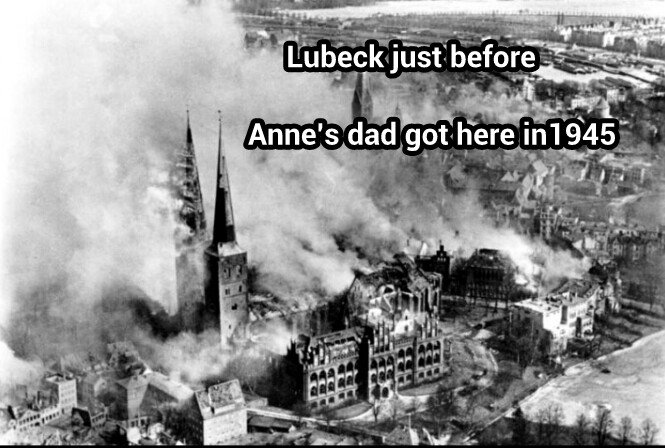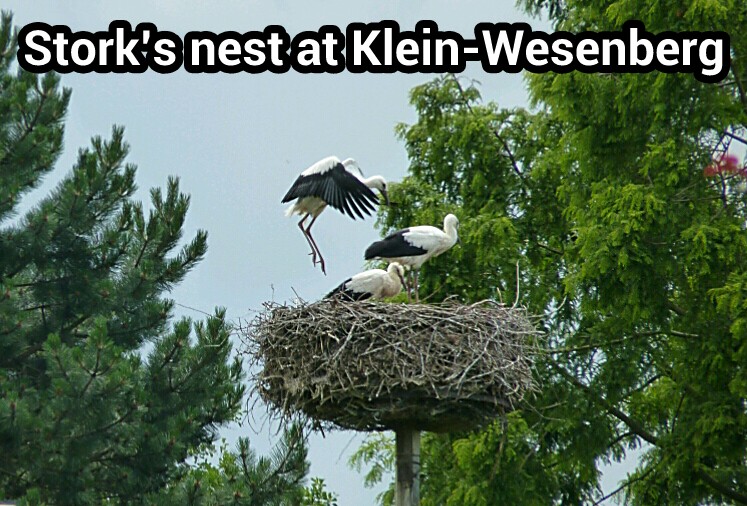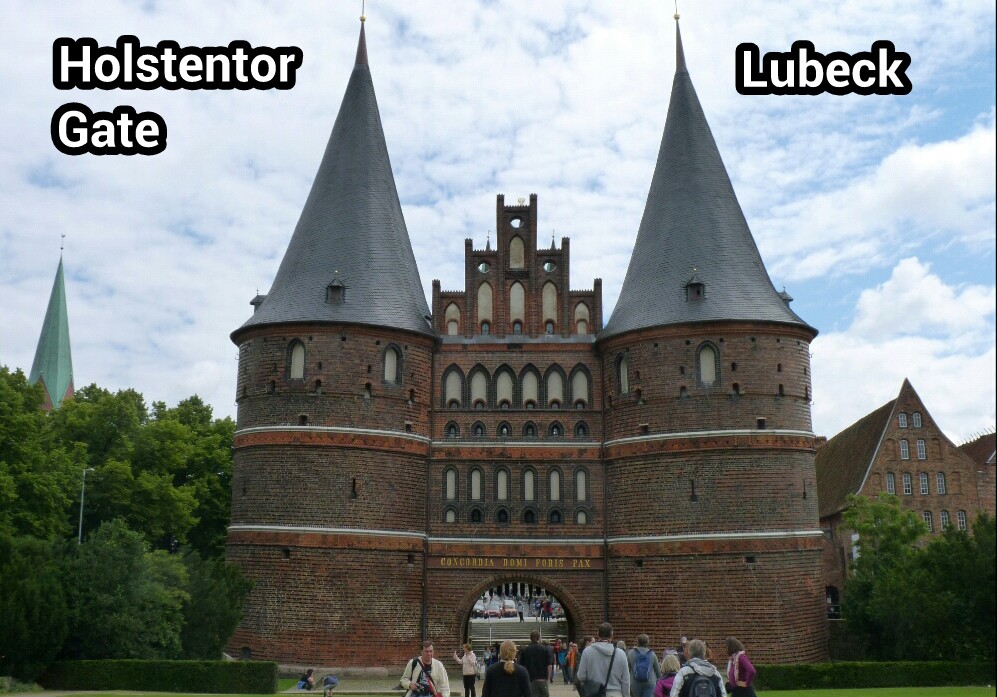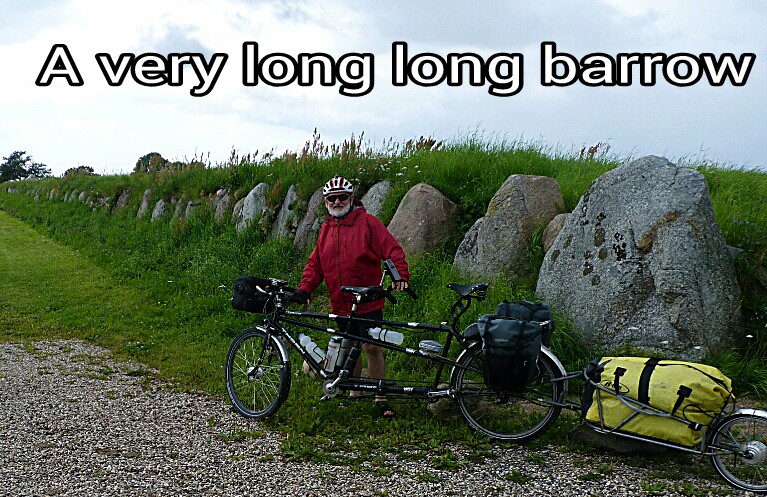Hamburg to Praesto in Denmark days 5 to 11 - 16th to 22nd July 2012
 |
The cycle route from Hamburg to Praesto
It is in yellow, move it around, click on "View Larger Map" and print it:
The Downloads:
The files are in .zip format. They need to be unzipped and saved to a directory of your choice. You can then load them into the appropriate application and GPS.
The Blog
Hamburg to Praesto
Days 5 and 6, 16th and 17th July
Duvenstedt to Lubeck and a day off in Lubeck
After four days spent mainly cycling we were just beginning to feel we were on a proper tour. And it feels good. We were away from our very pleasant hotel by 10am and soon out in the countryside.
It was pretty much flat to start with and the wind was on our backs. The clouds were rushing by but we had no thought that it would rain. Pretty little villages came up frequently and there was very little traffic. It was just what we needed to get used to cycle touring again.
As we moved further north and east we were confronted by the odd hill but Nanny helped us make short work of these. Even on minor roads and small villages cycle paths were the norm. On every main road that we used a cycleway was provided, often separated from the road by trees or a hedge.
After a while we approached Oldeslow, our first town since Hamburg. Even though it was busy the large numbers of cyclists were provided for beyond the wildest dreams of most British. We were expected to obey the rules of the road but in return had right of way over road vehicles at most crossings where there were no traffic lights.
Other cyclists were friendly and considerate but they did expect us to use the right side of the path. There was no conflict with pedestrians, in fact everyone gets along fine. Perhaps if we had not lost a generation of cyclists to the car it would be like this in the UK.
As we left town we began to think about somewhere to have our picnic lunch. As black clouds were beginning to amass shelter seemed a good idea. In the UK we often use church porches but most other countries don't have them. Even so, when we came across a church on a pilgrimage route with a seat in the garden we took a chance on the weather.
We were lucky in more ways than one. We only had a few drips of rain but more importantly we were able to watch a storks' nest as we munched away. As usual the nest was perched on a telegraph pole and there was at least one very large chick.
We are not really bird watchers but this is the furthest north and west that we have ever seen storks and it was a great treat.
It was a short ride after lunch via the ancient and picturesque city to the youth hostel at Lubeck. It is an extremely large and modern hostel with all the facilities that travellers need. It is a complete antidote to the pretentiousness of the Queen Mary. Mind you, we did have our own room and the other hostellers were fun and well behaved.
We spent our day off exploring Lubeck on the tandem and on foot. The photos say more than we can. Being a major inland port it was devastated during the war. The late Joe Hendry, the stoker's father, like many other soldiers, ended up here at the end of the war having fought across France, Holland and Germany in a tank.
We could not help wondering what this lovely city and its beautiful rural surroundings were like then. It brought to mind the futility of war both 65 years ago and now.
Day 7, 18th July
Lubeck to Gromitz
Every day is different. Today we left Lubeck via its industrial area. It became clear why it was such an important place during the war. In contrast to the tourist attractions here was a hard working place. There are still huge inland docks used by the ubiquitous European canal ships. There are factories doing dirty jobs and hopefully still transporting freight by water.
As many of the workers come to work by bike there was no problem finding cycle paths, making our route easy and safe. After about 10km we finally made it to the lovely quiet countryside. Taking a short break we sat enjoying the peace before resuming our ride on country lanes and tracks.
It was not long before the green countryside made way for the busy seaside. It was our first view of the Baltic Sea at Neustadt. We enjoyed cycling along the prom, sadly something we are not allowed to do at home.
On our right we had the white sandy beach dotted with the wicker chairs used in much of West Germany in the same way that we use beach huts. On our left we had the pleasant hotels and shops of the ethnic resort.
For what would come as a shock to many Weymouth councillors and residents we managed to cycle several kms along the prom without nearly killing a single person. In fact we slowed down because of the numbers on the prom and everyone was happy, the many cyclists, the cycle hire businesses, the pedestrians and even the dogs.
After a short but hilly excursion inland to navigate a headland we descended into Gromitz, another holiday resort, where we stayed at a hotel slightly away from the coast. All of the beach front hotels were booked by Germans on their holidays.
Our hotel, which was billed as a spa, was back from the sea in a countryside setting. It made up for not being by the beach by having a swimming pool which we enjoyed and the good food. Our lack of language skills is a shame. Every one here is German and it would be both nice and polite to speak to them. We have not heard an English voice since leaving the Queen Mary.
Day 8, 19th July
Gromitz to Burg auf Fehmarn
The management, using the excellent online Mapforge open cycle maps, had planned a route inland today. Based on yesterday's experience he decided to change it and try the mainly off road coastal route. All the technology worked and he drew the route on the tablet and transferred it to the GPS.
Yet again we had heavy showers so put off leaving until 11am. A combination of reasonable distances, long days and Nanny means that we can take a leisurely approach when we want to.
The rain eased and off we went through Gromitz's busy town centre following the management's new route. We were soon atop a dyke riding north along the coast. On one side we had the Baltic Sea and on the low lying ground inland a succession of caravan parks.
Even on this damp day it was pleasantly busy. There were many walkers and cyclists and the beach traders and sailing and surf schools were getting their gear ready for the rush when, or more likely if, the sun comes out. It was all extremely civilised and a nice way to spend a beach holiday.
As we went further north the trail became worse and was single track which is a bit risky for us on the tandem. We passed through Kallenhusen and Dahme before turning inland towards the bridge to Puttgarten. We had our picnic in the sun and all was well with the world.
Puttgarten bridge seemed a simple obstacle in this cycle friendly country. If only we had bothered to look it up on the internet. We came to the main E road leading to the bridge and about 4km from it. There were no signs but the only cycleway was on the west side of it.
We followed this cycleway for about 3km and came to a narrow gate giving access to the road. The stoker exercised her almost fluent German and deciphered the sign on it. She thought we could not go that way. She decreed, and she must be obeyed, that cyclists were not welcome and anyway had to walk.
The management, who sometimes knows his place and anyway had planned the route, continued onwards to the sea, confidently expecting to find a graded cycle path onto the bridge. This was not to be and after another 5km of searching we were right back to where we had first come across the road.
Many of you who have cycled with us may be under the false impression that we turned back. Those who have walked pushing bikes through bog, stinging nettles and cow fields to avoid a retrace will no doubt be chuckling. But we do assure you that while we did go round in an 8km circle we did not retrace.
In desperation we went onto the main road and cycled along the metre strip as fast as we could. This worked and by taking another fairly busy road we arrived at our hotel in the bustling town centre of Burg auf Fehmarn.
This all goes to prove that even in a cycle friendly country like this the engineers and designers give up on cycleways when the going gets tough. It is just that in the UK they give up much sooner and often don't even bother to start.
Day 9, 20th July
Burg auf Fehmarn to Nykobing Falster, Lolland, Denmark
Burg auf Fehmarn is a lovely busy little town but sadly most of the time we were there we had torrential rain. We were lucky to arrive just before it started. Rather than get soaked we ate in the hotel restaurant where the food was excellent and perhaps too plentiful.
We left soon after ten looking for whatever passes for an off licence here. We had run out of whisky and no way did we want to pay Danish prices. Luckily we found one and then had 25 minutes to make the 10h45 ferry from Puttgarten to Rodby in Denmark.
Nanny is a wonderful help up to 16kph but is useless above that and we needed to go faster. Following the route we rolled into the motorway style payage with a couple of minutes to spare. Following directions we cycled straight onto the ferry and made the tandem fast with the self help straps. The door shut behind us and the ship left immediately.
You get none of your Condor rubbish here. There is no one hour checkin. No get off your bike and walk because some idiot sued them ten years ago when he fell off and bumped his knee. And finally no jobsworth trying to tell a sailor how to secure his own tandem. If you fall off or your bike falls down it's your look out and quite right too.
We went straight to the top sun deck for the 18km 45 minute crossing. It was a lot easier leaving Puttgarten by ferry than by bridge and the bridge can't help but leave a bad taste.
As usual in Scandinavia the ship docked quickly and we left immediately, cycling the length of the car deck. Once ashore there was no sign of any formality, no security checks and no passport control. It will probably be more difficult for a Dorset resident to get into Weymouth for the next three weeks than it was for us and our whisky to get into Denmark. But enough of that.
The management was shocked, that's Echo speak for slightly confused, when the stoker pointed out a sign to Nykobing Falster saying it was 73km on the cycle route when he thought it was around 50km. Occasionally he has had to admit he is wrong but he was not convinced this time.
However with no alternative we continued on our planned route. This part of Denmark is called Lolland and by being flat, low lying and agricultural it is very like Holland. It differed for the first part of the ride by being an agricultural desert. Fields of wheat and barley stretched for miles and any human habitation or even signs of human life were few and far between.
As we cycled on the terrain became more interesting and there was even the occasional small hill, woods and villages. Around lunch time we came across a picnic bench beside an extremely large lake. As we sat eating our lunch we were delighted to see a red squirrel scamper along the nearby lane. The management has not seen one properly since the 1950's in Hampshire and the stoker had not ever seen one before.
As we pedalled on we came across some bird watchers but otherwise this lovely place was deserted. We found explanation boards indicating that we were in a lakeland area with special European status.
It was not long before we came to the busy town of Nykobing Falster and we checked into the youth hostel. The large building was strangely quiet compared with the Lubeck YH. However the facilities were fine and we had a ground floor ensuite room just big enough to store the tandem inside.
Nykobing Falster itself is a pleasant town with some interesting buildings, one of which did a decent veggy pizza and fish (certainly not "single") and chips.
Day 10, 21st July
Nykobing Falster to Damsholte
From the hostel we went straight onto cycle route nine which we followed almost all day. After about 5km we came across a very rare thing here, a village shop and a very large one at that. As we have the use of a kitchen tonight we bought enough supplies for dinner. We ummed and aahed a bit on the grounds that we would have to carry them all day but decided to get them anyway.
The route took us down to the Baltic Sea and around the coast of Lolland, much of it off road and again some single track. We were seldom much above sea level and the coast here is mainly wooded. The beaches are white sand topped with grassy banks.
It was quite different from the much more populated German coast. Here we met very few people and only the occasional house. The beach itself was deserted and the track through the forest very dark. For the first time we met other touring cyclists but have yet to see anyone from the UK.
We came across a nice little harbour. Most of the yachts were German and moored bow in to the quay with the stern tied to vertical posts. Surprisingly there was not so much as an icecream shop so yachts persons here, like cyclists, need to be self sufficient.
After a good long way we came to the ferry from Lolland to the little island of Bogo. It was a small elderly double ended wooden ferry with a lovely engine note, capable of taking about ten cars. As it was there were only two cars and eleven bikes. We were surprised at the fare, it was the equivalent of about £10 for the fifteen minute crossing.
Hovedgade where the ferry arrived was a pleasant village with picnic tables and a cafe. Today it was on the lee shore with a brisk and cold north westerly blowing. We decided to move on and found a fine bus shelter facing downwind.
We continued on the pretty route, turning our backs on an easy short cut and were glad we did. Now on the island of Mon we went into the Fanefjord church to escape from the first heavy rain shower of the day. Here in the 15th century an artist painted some magnificent frescoes on the church ceiling and these have now been renovated after centuries of being covered in whitewash. They should not be missed.
At the church we were directed to an important longbarrow nearby. This was also well worth seeing and is over 100 metres long despite the fact that it housed only one woman. We suppose she has almost achieved immortality.
A short stretch now on country lanes and along the coast, dodging the showers, brought us to our place for the night. We were just in time to watch the final time trial in the Tour de France and Bradley Wiggins clinch his victory tomorrow in Paris with Chris Groome the runner up. It just remains to see if Cav wins the sprint tomorrow.
Day 11, 22nd July
Damsholte to Praesto
We had a lazy day today with a kind of meandering zigzag route, the distance of which exceeded the management's by about 20%.
We were able to exit the hotel via the bedroom window saving a long portage. We did of course pay first and we also wished the landlady a happy birthday.
We then cycled off to look at the local church. It is both unusual and renowned locally because it was built in the 1700s in an unusual regency style. It was certainly unusual but for us the most interesting feature was the pulpit directly above the altar. To quote the guide book - the extreme Protestant ministers used it to preach hard sermons.
For the first time this tour it was sunny and warm with just fluffy clouds in the big low country sky. To be picky it was quite windy and it was not on our backs but it was almost ideal cycling conditions.
Our next stop was at Stege, east from where we were staying. This little coastal town is at the entrance to a huge fjord and also has an occasional ferry service to Zealand. Had we got up an hour earlier and been prepared to spend bucket loads of washers with holes in the middle we could have taken it.
Our journey continued west along the coast on a road busier than we liked and strangely there was no cycle lane. This brought us to the rather large bridge which links Mons to Zealand. At the foot of the bridge we wandered off to the right and explored the little port and yacht harbour at Kalvehave. It would be a nice place to stay whether by boat or bicycle.
After some more country lanes, this time in a northerly direction, we detoured very slightly to the tiny harbour of Sandvig. When we arrived we were the only people there other than a couple of local fishermen working on their boat.
As we ate our lunch sitting at one of the two large picnic benches a Danish cycling couple turned up, and soon afterwards two German lady cyclists arrived. So in this tiny village we had like minded people of three nationalities enjoying lunch together and sharing our experiences.
After lunch the management's day would not have been complete without an attempt at some off road. Unfortunately the track became more or less impassable by tandem and by mutual agreement we retraced. The management must be getting soft.
All that remained was for us to get supplies and to roll into our lovely seaside self catering cabin in time to watch the final stage of the Tour de France on TV.
We were delighted to see Wiggo lead Cav out to get his historic stage victory which makes him the tour's best ever sprinter. It was also equally important to see Wiggins as the first British winner of the Tour and to share the podium with Froome would have seemed impossible five years ago. We wonder whether the great British public still ask when these world sports super stars are going to get proper jobs.
Downloads for this route in Garmin Google Earth and .GPX formats


